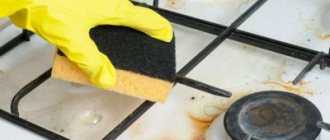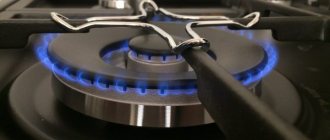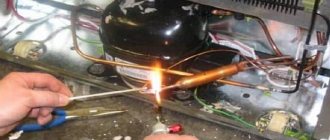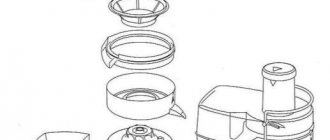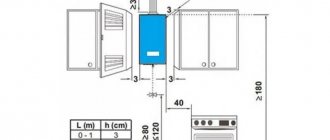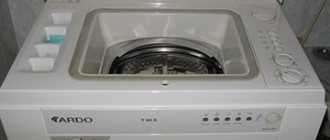Repairing a geyser with your own hands is a serious and dangerous matter. Any professional will tell you: “a geyser is a potentially dangerous piece of equipment, so you can only trust its maintenance and repair to a qualified specialist.” However, the ability to understand exactly which element has failed and what this can lead to will definitely not hurt.
DIY geyser repair
In addition, some faults that do not specifically affect gas equipment can be resolved on your own. Read the description of typical breakdowns and recommendations for action if they are detected.
Gas water heater device
Geyser refuses to ignite
Equipment may fail to light for several reasons.
Gas water heater device
Expert opinion: Masalsky A.V.
Editor of the “construction” category on the Stroyday.ru portal. Specialist in engineering systems and drainage.
First of all, you must make sure that the igniter is working properly. If it does not light, contact your gas service. A specialist will clean or replace the failed element. You cannot touch it yourself - it is dangerous.
Gas water heater diagram
In modern units with electronic ignition, if there is no ignition, the gas stops flowing - it is cut off by a valve. The user learns about this through the corresponding indicator. In some situations, this problem can be solved by simply replacing the battery. Please clarify this point in the instructions. If the manufacturer does not give such recommendations, it is better to immediately contact the gas service or a third-party repair service.
At one point the column may not light up
Battery pack for igniting the column
The column will not light up if there is no ventilation draft. To check the draft level, place a strip of paper near the ventilation grille. If the leaf does not change its position or does not change it sufficiently, there are obvious problems with traction. In apartment buildings, utility workers are responsible for cleaning ventilation shafts - contact them. You can do this yourself using a metal brush tied to a flexible wire (hose, etc.) of suitable length, but utility services usually do not approve of such unauthorized actions.
Ventilation cleaning
Often burners do not fire due to membrane wear. This structural element deforms quite quickly, the burner starting mechanism becomes less sensitive and does not work when the water is turned on. Even in expensive heaters, the membranes wear out within 5-8 years - unfortunately, nothing can be done about this.
Often burners do not fire due to membrane wear
To check, turn on the water to maximum. If the column turns on under strong pressure, the problem is definitely in the membrane. You can replace this element yourself.
To do this, do the following:
- unscrew the fastening nuts from the water unit (usually there are 2 of them);
- unscrew the fastening screws that hold the water unit in the gas unit (usually 3 screws);
- separate the halves of the assembly and you will see a rubber membrane. If it is not flat but noticeably warped, replace it. To do this, buy a similar product in a specialized store. If possible, give preference to a silicone membrane - it will last much longer than its simple rubber counterpart.
Expert opinion: Masalsky A.V.
Editor of the “construction” category on the Stroyday.ru portal. Specialist in engineering systems and drainage.
At the same stage, you can check the condition of the water intake filter. If it is clogged, clean it or replace it with a new one. To clean, simply unscrew the nut on the water supply side, remove the mesh and wash it or replace it with a new one, depending on the condition.
Find out detailed instructions on how to repair the Neva 4511 geyser yourself from our new article.
Repair of geyser Oasis
Chinese Oasis water heating devices have attracted attention on the domestic market, primarily due to their low price and simplicity of design, which allows for do-it-yourself geyser repair in almost any problem situation. The structure and format of the main parts are very similar to most domestic systems, so there are no problems with disassembly and repair, even if there are no repair instructions or diagrams for the Oasis gas water heater.
It is known from practice that Chinese Oasis gas appliances suffer from three types of defects:
- Rapid battery discharge;
- Failure of spark plugs;
- Water leakage on the seal of the membrane water pressure sensor.
In the first case, the problem with the batteries manifests itself in a rather unusual way; the indicator display pleases with blue or green light, but when you try to turn on the gas water heater, nothing happens. Repair of such a defect is carried out by simply replacing conventional salt batteries with alkaline cells with increased charge capacity. They should last for at least a year.
Disassembling the Oasis for repairs
If drops of water begin to appear under the column, this most likely means that repair of one of the flow parts of the water heating apparatus will be required. To determine the cause of water leakage and carry out repairs, the Oasis must be disassembled. First of all, it is necessary to remove the outer cladding of the device. To do this, remove the handles and unscrew the screws in the lower part of the body.
The next step is to disconnect the connectors from the indicator panel and microswitch.
We gain access to the future place of repair - the membrane water pressure control unit.
We repair the gas water heater control unit
In order to remove the pressure control unit, you must carefully disconnect the microswitch connector and remove the two screws securing the heat exchanger flange to the unit body.
It is clear that before repairing a gas water heater, the water must be turned off and the remaining water pressure in the system must be released by opening the tap.
For repairs, you will need to additionally remove the gas block of the water heater and the burner device.
The removed unit can be disassembled for repair by removing four steel screws. Typically, steel fasteners stick strongly to brass, so the joint is pre-treated with VD-5 or brake fluid.
The pressure control unit operates as follows:
- Inside the housing there is a cavity divided by a membrane into two parts. Water approaches on one side, in the second cavity there is a round float, on which water presses through the membrane;
- The float has a rod that passes through a rubber seal. When the hot water tap is opened, the flow fills the cavity in the block, pushes the rod through the gland through the membrane and float and presses the contact on the microswitch;
- The circuit closes, the gas opens, and the ignition device is activated.
It is clear that the surface of a steel rod, when in contact with rubber, intensively corrodes and becomes covered with cavities. Each movement of such a rod leads to catastrophic wear of the oil seal, which begins to leak within a year. In addition, during any repair, at the first opportunity it is necessary to change the membrane to a high-quality rubber one.
A situation often occurs when, before repairing the seal, the geyser begins to boil and spew steam. This suggests that the membrane also needs to be cleaned of dirt and, if possible, replaced.
Repair of the geyser electrode system
Chinese manufacturers of Oasis geysers always like to save on the quality of the materials used. An example is a situation where a new, fully operational gas water heater stops igniting even with a working water and gas control unit and ignition board.
The reason is the failure of one of the three spark plugs of the burner flame. The design of the burner device is such that in order to ignite the gas, it is necessary that all three spark plugs be in good working order.
Repairing the gas water heater ignition system begins with identifying the faulty spark plug. To do this, you need to remove the cladding, turn off the lights and shade the room. When starting the gas water heater, you can see how on one of the spark plugs the electric discharge strikes not into the gas flow, but much lower, into the housing.
The situation is extremely dangerous and requires urgent repair of the ignition system of the gas-air flow in the column. Repairs cannot be postponed, even if the column lights up the second or third time it is started. When starting, a large amount of a mixture of gas and air is pumped into the fuel chamber and exhaust device, and if the ignition of the column is triggered with a long delay, an explosion and fire are possible.
For repairs, it is necessary to dismantle all three spark plugs, clean them of carbon deposits and oxidation products. One candle definitely pierces the body, the rest are unknown in what condition, so all three are put in an insulating heat-shrinkable polymer tube, at least three or four layers. During the repair, you will need to insulate the clamping bar in the same way, which secures the spark plugs to the burner body.
The geyser goes out
The geyser goes out.
If the heater turns on but goes out, the problem in most situations lies in the bimetallic temperature sensor, which is necessary to protect the equipment from overheating. Also, due to malfunctions of this element, the heater may not turn on at all.
This problem has 2 main development scenarios.
- In the first scenario, the burner lights up properly, the equipment functions for some time without any complaints, and then goes out and shows no signs of life for some time - attempts to ignite the heater lead to nothing. Usually after 20-30 minutes the equipment turns on again and history repeats itself. This occurs due to the excessive sensitivity of the sensor. As a rule, it is “congenital”, i.e. This is a factory defect. It is extremely difficult to do something on your own. It is better to immediately contact the manufacturer’s service for warranty repairs.
- In accordance with the second scenario, the column may turn off chaotically, and sometimes not turn on at all. The reason, as a rule, is the wear of the insulating material of the bimetallic sensor conductor. There is a banal short circuit to the housing, as a result of which the safety valve is activated and the column begins to behave abnormally.
Contact the service center for warranty repairs
There is no point in contacting gas workers - the defect is clearly not a “gas” defect. There is also no need to try to get rid of the breakdown yourself - you can only break the unit. Contact the service center for warranty repairs.
What can you repair in a gas water heater with your own hands?
Of course, a gas hot water heater does not always wear out or break so thoroughly and irrevocably that it is impossible to do without the help of a specialist. According to reviews from the same mechanics of the gas maintenance service, in 70% of cases, repair of geysers comes down to routine maintenance and elimination of minor defects, usually associated with low quality parts or incorrect adjustment.
The list of works available for repairing geysers at home can include the following:
- Minor repairs and repackaging of coupling and nut joints of pipelines;
- Replacing the elastic membrane in the water-gas column regulator;
- Cleaning and adjusting the operation of the draft sensor;
- Cleaning and washing the heat exchanger;
- Ignition board repair.
A separate category can include such operations as repair and soldering of heat exchangers.
It is clear that there is a certain category of expensive hot water heaters, full of automation and electronics, which there is simply no point in even trying to repair at home. For example, repairing Electrolux or Vaillant geysers will cost less at a service center due to the high cost of spare parts. The exception is particularly important components, such as a three-way valve or ignition board; it is better to buy them from an authorized dealer, even if the price is higher. This is the only chance to carry out repairs and not destroy an expensive Italian or German speaker with substandard spare parts.
Water comes out with weak pressure
Water comes out with weak pressure.
Most often this happens due to the column heat exchanger being clogged with scale. Typically, the cause of clogging is prolonged “idle” firing of the igniter. The device heats the heat exchanger to a temperature sufficient to evaporate any remaining moisture.
There is no water flow, scale is not washed out of the heat exchanger, and before the next time the equipment is turned on, it sets, as a result of which the column ceases to function normally. Cleaning the heat exchanger usually helps. In advanced cases it has to be changed.
To replace it, it is better to immediately contact professionals, but you can handle the cleaning yourself. Prepare screwdrivers, rubber hose, open-end wrenches and paranitic gaskets. Buy a descaling mixture from a hardware store. This is usually called anti-scale. A more budget-friendly option is washing with vinegar essence. Work in this order.
The best all-purpose descaling products
First step. Sequentially remove the fittings and casing from the heater.
Second step. Shut off the water at the inlet and open the hot water tap, preferably as close to the water heater as possible.
Third step. Unscrew the water supply tube from the heat exchanger and then move it to the side. After unscrewing the nut, the column heat exchanger will begin to release water. In total, about 1 liter will be drained.
Fourth step. Place a hose of a suitable diameter onto the inlet of the heat exchanger and lift it slightly above the heater. Insert an ordinary funnel into the attached hose and begin to slowly pour in the prepared solution in a thin stream (preparation instructions are given on the package). There's no need to rush. If you pour too quickly, the antikipin will simply push it back out, and you are unlikely to like it.
Flushing the geyser heat exchanger
Leave the cleaning agent in the heat exchanger of the heater for 2-3 hours (usually the required time is indicated on the packaging).
Place a suitable container under the water tap and carefully resume the flow of liquid to the heater. Observe what comes out of the hose. Did a lot of sludge come out, and then the pressure returned to normal? Everything is fine. Otherwise, the washing will have to be done again. Typically, the need to re-rinse occurs only when using vinegar essence. Antiscale can cope with most situations the first time.
Repair of geyser Neva
Most models of Neva geysers have proven themselves to be simple and easy-to-repair water heating devices. They are far from the reliability of European models, but repairing them is much cheaper, and you can almost always do it yourself.
Failure and subsequent repair of a spark plug is considered by the rules to be an atypical case of breakdown, therefore, after performing repair work, it would be correct to look for the cause of the defect. Most often, plastic burnout occurs due to condensation flowing through the ventilation system onto the body of the gas burner.
How to repair a heat exchanger union nut
One of the most common defects of Neva geysers for almost all models is the low quality of the metal of the heat exchanger. According to the rules, the heat exchange circuit through which water moves should not come into contact with aluminum parts, for example, a gas burner or a control unit. Any such contact can cause electrochemical corrosion of the copper walls, and then repair will simply be useless.
In addition, the rules for tightening the union nuts that secure the heat exchanger to the regulator and outlet pipe are not always followed. With each heat exchanger removal and repair, the nuts cut a thin, barely visible path into the copper wall. Ultimately, the flared end and part of the copper pipe simply break off the tenth time of twisting.
In this case, you have to trim and level the area of the breakdown, install a new nut with an external thread, and connect the heat exchanger to the control unit with a regular flexible hose. Any other repair option, as practice shows, turns out to be short-lived.
Repair of a microswitch in the geyser starting system
A situation similar to the Oasis with dead batteries also happens with the Neva gas water heater. When you try to start the Neva, the indicator board lights up, but the gas burner does not ignite. Sometimes the column can be turned on 4-5 times.
In this situation, repair of the microswitch is required due to premature wear of the part or improper adjustment of the unit.
The switch is located next to the water pressure control unit. When the column starts, the membrane on the block pushes out the rod, which unlocks the switch contact. Unlike the Oasis, all parts of the unit, including the rod, are made of brass, so there is no corrosion; the microswitch itself must be repaired and replaced.
To perform repair work, you need to disconnect the connector, unscrew two M3 screws and remove the switch housing from the strip, as in the video
Replacing the microphone is easy. You can buy an original part for 400-500 rubles. in a specialized salon or purchase an analogue for 50 rubles. in any radio parts store. There is no difference for repairs; in both cases they will sell a part from Chinese consumer goods.
In order to carry out the repair, you will need to unsolder two wires with a connector from the switch legs, put on a heat-shrinkable tube and solder them to the contacts of the new part.
At the final stage of repair, the switch is screwed with old screws onto the mounting strip on the block. Next, you need to adjust the position of the microswitch body so that the rod completely releases the contact when moving. This is done using mounting screws. One of the screws bends with a radius; accordingly, by rotating it, you can move the switch body in the desired direction.
Column "claps"
The column “pops”
In such a situation, it is better to immediately contact a professional. He will make adjustments, which are extremely difficult to make without knowledge of the matter, and the column will begin to work normally.
You can find out the reasons for the appearance of such a malfunction for general development. There are two main reasons:
- gas flows under too much pressure. The heater lights up too actively, which leads to a fire failure;
- gas flows at too low a pressure. Air penetrates into the heater burner, which leads to a micro-explosion, which is interpreted by human hearing as a bang.
Bosch geyser repair
Water heating gas appliances produced by Bosch are distinguished by their compact size and enormous automation capabilities. The more components and mechanisms there are in the design, the greater the likelihood of failure.
Bosch WR10 water heating systems are characterized by two types of breakdowns - random shutdown after a successful start and leaking seals due to high water hardness.
Arbitrary shutdown can occur for three reasons:
- Loss of draft in the chimney;
- The ignition electrode is dirty, as a result of which the automation does not recognize the very small ionization current and turns off the gas supply. Repair comes down to regular cleaning of the electrodes;
- Triggering of the heat exchanger overheating sensor.
The last case is the most relevant. The overheating sensor is a bimetallic plate with contacts. When a certain temperature is reached, the plate bends and opens the contacts.
To restore it, you first need to check the operation of the sensor, for example, short-circuit the contacts directly with a paper clip or copper wire. If the geyser continues to operate normally, then you need to buy and replace the sensor. Severe overheating means that the gas flow regulator will need to be adjusted and tested.
The water heater does not heat the water enough
The water heater does not heat the water enough.
This usually happens due to the insufficient power of the gas water heater. The user begins to demand more from the equipment than it can do.
There are two options to solve the problem:
- we stop abusing and do not open hot taps at all water intake points at the same time;
- We buy a more powerful speaker.
Expert opinion: Masalsky A.V.
Editor of the “construction” category on the Stroyday.ru portal. Specialist in engineering systems and drainage.
Also, inadequate heating of the liquid may occur due to a clogged burner. Look at the color of the fire. Under normal conditions it is bluish. If the flame turns yellow, contact a gas specialist. You can only trust such repairs to a professional, because... This is already a “gas” breakdown.
Repair of heat exchangers of geysers
One of the most severe cases of column damage is considered to be burnout, fracture or through corrosion of the copper heat exchanger. In the first two cases, repairs are performed only by replacing the part with a new spare part. In the case of through corrosion, thin, 02.-0.5 mm holes are formed on the walls of the heat exchanger, through which water flows out of the circuit.
A defect, as a rule, is detected by intense soot formation, water leakage and a drop in pressure in the circuit when the tap is closed.
To repair the heat exchanger, you will need to remove it from the geyser mount. Next, the copper surface is cleaned of layers of soot and scale and subjected to a hydraulic test.
The easiest way is to identify the location of corrosion by pumping air or water under excess pressure. For example, the output of the heat exchanger is plugged with a rubber plug, and air pressure is applied to the inlet using a hand pump. The geyser heat exchanger is immersed in a container of water and the location of the damage is determined.
You can repair the damage at home by soldering with copper-silver tin solder. The first is used to restore the hottest spots located close to the flame front. To seal with tin, the copper surface is etched with a solution of zinc in hydrochloric acid, heated with a torch and tinned with a massive piece of solder. For normal operation, the thickness of the tin patch must be at least 0.5-0.7 mm.
After repair, the heat exchanger is checked twice more - using traditional air injection and holding it under operating water pressure after installing the unit on a gas water heater. The pressure in the circuit should not drop for at least 15 minutes.
The main causes of geyser failure
The heat exchanger is clogged
Among the most common causes of malfunctions of water heating units is the formation of scale inside the radiator. Most often, the catalyst in such processes is a high level of water hardness. Scale, in turn, appears when the temperature of the liquid is heated to 80 degrees; if the temperature exceeds this limit, the processes are activated.
Correct operation of the gas burner will help you get rid of such consequences. Do not install the unit at high temperatures; for bathing, washing clothes in an automatic machine and washing dishes, heating the water to 60 degrees is sufficient.
Apartment owners especially often face the problem of scale formation in the heat exchanger, leaving the product to work using the igniter in constant mode. As a result, within an hour the temperature reaches 90 degrees, and scale formation can no longer be avoided. In this case, it is advisable to connect the installation as needed and not modify the automatic device in your own way. Or don’t be surprised why the device doesn’t work.
But what to do if a breakdown has already occurred, how to eliminate it and repair the unit? First, you should make sure of the reason, namely, if hot water flows from the tap in a thin stream, while there are no problems with cold water, and at the same time the column refuses to turn on, this means that the problem is scale.
Arm yourself with screwdrivers with different attachments, a set of open-end plumbing wrenches, a number of gaskets and a rubber elastic hose. You can’t do without anti-scale, which can be purchased at any hardware store. In extreme cases, the product is replaced with vinegar essence.
Remove the water heating product from its fittings and casing, turn off the water supply and open a tap close to the column. Unscrew the nut from the battery and wait until the water has completely drained into a previously prepared container.
Pour the product through the hose attached to the inlet of the heat exchanger. Do this carefully so that the anti-scale agent does not spill out. Leave the gas water heater for several hours, then turn on the water. The presence of a large amount of dirt in the liquid and strong pressure means that you have completed the task. If you feel that some of the scale still remains inside, do the same manipulations again.
Leak detected
If the geyser does not work due to a leak being detected, ideally you should replace the outdated radiator device with a new one. However, the price of heat exchangers reaches one third of the total cost of the entire product, so it is more advisable to repair it yourself.
Soldering, which can withstand up to 100 degrees of water heating, will help with this. Open the hot water, remove the nut from the cold pipe, wait until the water drains. If some liquid remains inside, blow the product with a vacuum cleaner.
The leak is eliminated by soldering
You should start soldering by cleaning the area with a piece of cloth treated with a solvent. Walk along the surface of the fistula with fine-grained sandpaper. Rosin can act as a flux; if it is not available, crushed aspirin tablets will do.
As a result, the solder thickness should be 1–2 mm. You can assume that the fistula has been eliminated. Feel the heat exchanger pipe, if you notice a green spot, it means there is a micro-hole in this place, take care of it too.
Gas device does not ignite
The reasons why the device cannot be ignited are simple: there is no draft in the ventilation. Perhaps the chimney is clogged or an object has fallen inside. In this regard, modern water heating models have a control and protection system, according to which gas stops flowing.
To repair the device, you need to check the presence of traction. Light a match and place it close to the chimney, the flame sways - there is a draft.
It is not possible to light the speaker if the batteries are discharged. Weak water pressure is also a signal for the device to stop heating. Alternatively, you may need to clean the filter, presented in the form of a fine mesh. Move the nut aside, pull out the mesh and clean thoroughly.
Determine the condition of the membrane component - unscrew the two nuts and three screws securing the water unit. It should be separated and the membrane should be washed to remove dirt. The membrane, made of silicone, lasts longer than its analogues.
The geyser heats up incorrectly
This can happen if the unit is equipped with low power. This shortcoming can only be corrected by purchasing a new model.
Frequent breakdowns of the geyser are a reason to replace it
If the color tone of the flame has changed, the product is probably clogged. Adjust the gas supply to the burner using a tap that determines the volume of water moving through the column within one minute. Reducing the bandwidth manually helps fix the problem.
Very hot water coming out is not a defect, so no repairs are required. Limit the gas supply using the gas valve shut-off mechanism installed at the inlet of the water heater located on the pipe.
Geyser does not heat water well
This can happen for several reasons.
- The simplest reason is that the gas water heater is not selected correctly . You saved money and bought a low-power heater that is unable to satisfy your hot water needs.
- The second reason is low gas pressure in the pipes (in the apartment). Call a gas technician to check the system.
- The third reason is a common blockage (nozzle, filters, scale, hoses, etc.), some types of which are described above. You can check this by the color of the fire, which changes from time to time. This is evidenced by the presence of soot.
You can only adjust the temperature and clean the column yourself.
Remember! Self-adjustment of the gas water heater and troubleshooting requires special care. If the work is performed poorly, not only you, but also completely innocent people may suffer. If you have the slightest doubt in your abilities, you should turn to gas service professionals.

